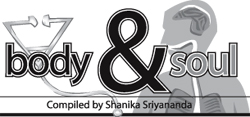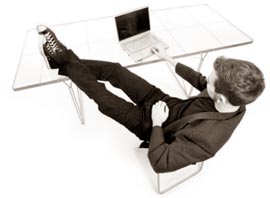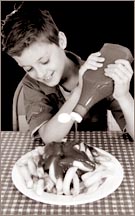
Avoiding health hazards at work
by B. Samarasinghe
|

Bad posture can lead to fatigue and aches
|
Today most of us spend our working days carrying out repetitive
activities in awkward or static postures. At first we will not be aware
of this because it feels comfortable. If we do not sit properly, take
regular breaks and also use correctly positioned furniture and
equipment, we can become vulnerable to pain and discomfort.
Prolonged sitting postures incur static muscle work, which is less
efficient than dynamic muscle work, and allows a build up of lactic acid
- a thick colourless fluid formed during muscular activity by the
breaking down of glycogen - causing fatigue and aching. To offset this,
it is essential that exercises are performed at frequent intervals
during the day.
Common problems include a range of work - related disorders, such as
pain in the limbs, fingers, forearms, neck, shoulders and back. These
conditions are usually related to overuse and can become debilitating if
left untreated.
The good news is that these disorders are preventable.
Physiotherapist can successfully treat the symptoms and identify some of
the possible causes. This article helps you to identify your risks and
offers simple exercises you can follow to help prevent the onset of
problems.
Risk factors
These disorders can affect people in many type of work, including
those who spend long period at their desks, computers and production
workers who frequently repeat the same pattern of movement.
It can even cause problems to drivers and those who play musical
instruments or participate in sport.
* Prolonged maintenance of awkward or static postures.
* High rates of repetition.
* Frequent exertion of force.
* Heavy lifting or handling.
Even stress, which causes muscles to tense, can be a contributing
factor as can adverse working environments, such as those that are too
hot or too cold, inadequate illumination, poor air quality and noise
levels, need attention.
What can your employer do?
Your employer should be keen to cut your risk disorders because a
healthy workforce is generally motivated and productive.
They should provide:
* Workstation risk assessments conducted by a trained risk assessor.
* Changes to workstations where necessary, based on sound ergonomic
principles (study of efficiency of persons in their working environment)
* Changes to work patterns if needed, such as a wider variety of
tasks, job rotation and regular breaks for computer - based or
repetitive work.
* Appropriate information and training in safe computer use.
* Eye tests for those using display screens and spectacles if lenses
are needed.
* Encouragement to take allocated breaks.
What can you do?
* Aim for a good balance between sitting and moving around your work
environment. Vary your posture frequently. Performing a few simple
exercises, as described, every hour also can help reduce your risk of
work - related aches and pains.
* Exercises will boost your circulation, which sends more oxygen to
your brain and helps you stay alert.
If you are experiencing any concerns of discomfort, it is your
responsibility to seek early advice and inform your employer.
How can physiotherapy help?
Physiotherapist offer advice and treatment for a range of health
problems to help you make the most of your lifestyle. They can advise on
ergonomics, risk assessment and management relating to workers and their
activities, including manual handling.
They are also involved in rehabilitation and will provide a programme
of treatment to suit your needs. They will ask you for a full history of
any symptoms and discuss workplace risks, your hobbies and any stress
factors. Physiotherapist will analyze your posture and offer corrective
advice and exercises. They will also took at ways to improve your
working practices.
Protecting the next generation
Nowadays, young children, saddled with heavy school bags, are tapping
away at computer keyboards, using mobile phones and playing video games.
The increasing use of computers in schools and at home means they are
also at risk of computer related musculoskeletal aches and pains.
As a consequence some children today have hardly any time to indulge
in physical activities and sports, which is worrying. Parents, carers
and teachers have a responsibility to ensure the principles of good
ergonomics are applied at home and in the classroom.
Ensuring that children know how to sit correctly, vary their
activities and build plenty of physical activity into their daily lives,
can help minimize the risk of developing common conditions associated
with modern computer use.
Fit to work stretching exercises
All exercises should be done gently. Sit comfortably and take five
slow deep breaths before starting the exercises. Breathing should be
relaxed throughout. Repeat all exercises three times.
Forearms stretch
Gently interlock your fingers. Press your palms away from your body,
gently stretching the forearms muscles, fingers and muscles between your
shoulder blades. Hold for five seconds.
Back of forearms and wrist stretch
With your elbows straight, tuck your thumb in and make a gentle fist.
Bend your wrist forwards gently stretching the forearms muscles, wrist
and fingers. Hold for five seconds.
Chin tuck
Sitting tall, imagine you are suspended by a piece of string from the
crown of your head. Keeping eyes level with the horizon, tuck your chin
in to make a double chin. Hold for five seconds.
Side to side turn
Sitting slightly forward in your seat, rotate your mid - and upper
back to the right, holding on to the backrest of the chair with your
left hand. Hold for five seconds. Repeat in the opposite direction.
Elbow flare
Put your hands behind your neck, loosely grasped. Keep head and neck
tall. Squeeze below the shoulder blades and take elbows back, taking
care not to press on the neck.
Hold for five seconds.
Neck turning
Rotate your head left then right, taking care to keep your eyes on
the horizon and aiming your chin at the shoulders. Use your eyes to
focus on something in the distance for five seconds.
Shoulder retractions
Stand or sit up straight. Pull your shoulders back behind you
squeezing shoulder blades towards each other. You should feel the
stretch across your chest. Hold for five seconds.
Back stretch
Stand up and put the heel of your hands into your lower back. Draw
your elbows back and down. Keeping your head and neck steady with chin
tucked in, slowly arch your back and look to the ceiling. Hold for five
seconds.
Junk food leads to cancer
 Junk food is not only causing obesity but heartburn or acidity
leading to ulcers and even cancer in food pipe, a study claimed. Junk food is not only causing obesity but heartburn or acidity
leading to ulcers and even cancer in food pipe, a study claimed.
The nation-wide study has found that heartburn is affecting about
three out of five urban Indians.
The study conducted in Delhi, Mumbai, Kolkata, Chennai, Ahmedabad,
Lucknow, Bhopal and Hyderabad showed that irregular food eating habits
is another cause for heartburn among 71 per cent of the urban adult
population.
"Food related problems constitute the largest chunk of reasons
leading to acidity. Junk food and irregular food eating habits are the
two main reasons for acidity," Anup Singh, who heads the Health Care
Welfare Society, an NGO that works on health-related matters.
"In most parts of India, people love to eat out and that results in
Gastroesophageal Reflux Disease," he said. GRE is a condition in which
acid, bile and partially-digested food in the stomach back up into the
esophagus, the tube that carries food from the mouth to the stomach.
Heartburn happens when the esophagus comes in contact with stomach
acids.
If it is overlooked or not treated, it could lead to ulcers and
bleeding of the esophagus. Also, there is a danger that it could lead to
the cancer of the food pipe or esophagus," Singh said.
Spicy and chilly based food like pizza, spicy curries, chips and
snacks - a must at parties, celebrations and social gathering are the
main culprits (10 per cent) that are changing eating habits as well as
interfering with lifestyle activities. Fifty-seven per cent of frequent
heartburn sufferers said that irregular eating habits especially eating
out have caused them heartburn more than once in a given month.
Apart from spicy food, the other factors that result in heartburn are
long working hours (9), stress (7) and lack of sleep (6).
Episodic heartburn (that occurs more than two times in a week) is
less serious and more common. "A number of people manage their symptoms
by avoiding certain foods or take Diegene, Eno or Pudin Hara to get
constant relief," Singh said.
But for those with frequent heartburn, it could be a sign of
something more serious. The rise of the heartburns portrays the study of
social change in urban India where long working hours and erratic
lifestyle have made it harder for people to prepare balanced meals at
home, increasing the appeal of fast food and on-the-go-snacks, he said.
Singh said heartburn strikes when there is a burning pain in chest
and throat, belching often with chest discomfort. The other signs are
indigestion, nausea and vomiting, diarrhoea or constipation.
"As there are so many people suffering from fits of heartburn, people
dealing with frequent heartburn aren't always sure if their problem is
out of ordinary. One should take it seriously if their symptoms
continue," the report said.
The Hindu
Migraines:
Risk factor for heart attack
Painful migraine headaches are a warning that more dangerous pain may
lie ahead.
 A new study shows in men what earlier studies showed in women: People
who get migraines are at higher risk of heart attack and stroke than are
people who don't get migraines. A new study shows in men what earlier studies showed in women: People
who get migraines are at higher risk of heart attack and stroke than are
people who don't get migraines.
For women, the risk is confined to those who get migraines with aura,
a before-headache phenomenon in which a person may see flashes of light
or smell odd odors.
That's probably true for men, too, says study researcher Tobias Kurth,
Assistant Professor of Medicine at Harvard Medical School, although the
men's study was unable to address this issue.
"It looks like it is only migraine with aura that is causing the
potential problem. And that is the minority of migraine sufferers,"
Kurth tells WebMD. "Even among those with aura, the absolute risk for an
individual, it is a moderate to small risk."
Migraine isn't as big a heart disease risk factor as high
cholesterol, high blood pressure, or obesity - but it is a risk. The
Kurth study compared men with identical heart disease risk factors.
Those with migraines were 42% more likely to have heart attacks.
"In terms of prediction, we can identify migraine as a predictor of
cardiovascular disease," Kurth says.
The problem isn't the drugs migraine sufferers use. Migraine
sufferers take the same medications, in the same doses, whether or not
they have auras. Yet the risk seems to be confined to those who
experience migraine with aura.
Why would a headache cause a heart attack? Nobody knows. But there
are several possibilities, suggests Richard B. Lipton, MD, professor of
neurology, at Albert Einstein College of Medicine, Bronx, N.Y. "One
possibility is that having migraine attacks causes atherosclerosis,"
Lipton tells.
What makes this plausible is that heart disease is linked to
inflammation, an immune process that causes blood vessels and other
tissues to set off emergency alarms throughout the body. Migraine
attacks trigger inflammatory responses.
Another possibility is that the same genetic factors that underlie
heart disease also underlie migraine with aura. Migraines usually appear
in young adulthood, while heart disease usually appears much later. So
migraines, rather than causing heart disease, could simply be an early
warning sign of trouble ahead.
Lipton says there is a bright side to having migraines with aura.
"Knowing that migraine is a risk factor creates an opportunity to
change your more serious risk factors and to reduce your risk," he says.
"Stop smoking, control your blood sugar, don't be obese, lower your
cholesterol, and lower your blood pressure.
If people see their migraines as a signal to take better care of
themselves, this finding will have public health benefit."
WebMD Medical News
|
